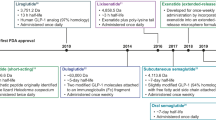Summary
The disposition of the gonadotropin-releasing hormone (GnRH) agonist buserelin was studied in male rats under conditions of long-term administration. Rats were continuously infused with about 30 pmole [3H]-buserelin/24 h subcutaneously by osmotic minipumps for 4–7 days. After killing the rats, the3H-activity of the tissues was measured and was found to be highly concentrated (about 10-fold to plasma) only in the pituitary. The daily amounts of3H-activity excreted in urine and faeces were constant over the whole infusion period, suggesting steady state conditions. On a molar basis, of the infused dose of buserelin, 14.8% was found to be excreted into urine as intact peptide, and 16.5, 10.8 and 20.6% as the partial buserelin sequences 1–2, 1–3 and 5–9. It is concluded that the major elimination route of buserelin, constant with time, is glomerular filtration, followed by enzymatic degradation of part of the filtered peptide by kidney tubuli enzymes to the partial sequences 1–2, 1–3 and 5–9, which reflects the proteolytic breakdown of buserelin by kidney membrane peptidases in vitro. Based on the similarities in the pharmacokinetics, in vivo metabolites, and in vitro enzymatic degradabilities among the GnRH agonists that have the native GnRH sequence modified at position 6 with or without additional modification at the C-terminal, the elimination process as shown here for buserelin should also be valid for other GnRH agonists.
Similar content being viewed by others
References
Moghissi K.S. (1992): Clinical applications of gonadotropin-releasing hormones in reproductive disorders. Reprod. Endocrinol., 21, 125–140.
brogden R.N., Buckley M.M-T., Ward A. (1990): Buserelin. A review of its pharmacodynamic and pharmacokinetic properties, and clinical profile. Drugs, 39, 399–437.
Flouret G., Majewski T., Peterson D.R., Kenny A.J., Carone F.A. (1987): Effects of D-amino acid substituents on degradation of LHRH analogues by proximal tubule. Am. J. Physiol., 252, E320-E326.
Molineaux C.J., Lasdun A., Michaud C., Orlowski M. (1988): Endopeptidase 24.15 is the primary enzyme that degrades luteinizing hormone releasing hormone both in vitro and in vivo. J. Neurochem., 51, 624–633.
Berger H., Heinrich N., Albrecht E., et al. (1991): Gonadotropin-releasing hormone (GnRH) analogs: relationship between their structure, proteolytic inactivation and pharmacokinetics in rats. Regul. Pept., 33, 299–311.
Kertscher U., Brudel M., Mehlis B., Sandow J., Berger H. (1995): Pathways of degradation of buserelin by rat kidney membrane. J. Pharmacol. Exp. Ther., 273, 709–715.
Chu N.I., Chan R.L., Hama K.M., Chaplin M.D. (1985): Disposition of nafarelin acetate, a potent agonist of luteinizing hormone-releasing hormone, in rats and rhesus monkeys. Drug Metab. Dispos., 13, 560–565.
Berger H., Sandow J., heinrich N., Albrecht E., Kertscher U., Oehlke J. (1993): Disposition of the3H-labelled gonadotropin-releasing hormone analog buserelin in rats. Drug Metab. Dispos., 21, 818–822.
Oehlke J., Brankoff T., Schmidt M., Brudel M., Kertscher U., Berger H. (1993): An investigation into the catalytic deuteration and tritiation of dehydroproline9-buserelin. J. Labelled Comp. Radiopharm., 33, 161–169.
Igari Y., Sugiyama Y., Sawada Y., Iga T., Hanano M. (1983): Prediction of diazepam disposition in the rat and man by a physiologically based pharmacokinetic model. J. Pharmacokinet. Biopharm., 11, 577–593.
Gerlowski L.E., Jain R.K. (1983): Physiologically based pharmacokinetic modeling: principles and applications. J. Pharm. Sci., 72, 1103–1127.
Cocchetto D.M., Bjornsson T.D. (1983): Methods for vascular access and collection of body fluids from the laboratory rat. J. Pharm. Sci., 72, 465–492.
McGuill M.W., Rowan R.N. (1989): Biological effects of blood loss: implications for sampling volumes and techniques. ILAR News, 31, 5–18.
Okada H., Inoue Y., Heya T., Ueno H., Ogawa Y., Toguchi H. (1989): Pharmacokinetics of once-a-month injectable microspheres of leuprolide acetate. Pharm. Res., 8, 787–791 (1989).
Turner A.J., Matsas R., Kenny A.J. (1985): Are there neuropeptide-specific peptidases? Biochem. Pharmacol., 34, 1347–1356.
Kenny A.J., Ingram J. (1987): Proteins of the kidney microvillar membrane. Purification and properties of the phosphoramidon-insensitive endopeptidase (endopeptidase 2) from rat kidney. Biochem. J., 245, 515–524.
Stephenson S.L., Kenny A.J. (1988): The metabolism of neuropeptides. Hydrolysis of peptides by the phosphoramidon-insensitive rat kidney enzyme endopeptidase 2 and by rat microvillar membranes. Biochem. J., 255, 45–51.
Erdös E.G., Skidgel R.A. (1989): Neutral endopeptidase 24.11 (enkephalinase) and related regulators of peptide hormones. FASEB J., 3, 145–151.
Chan R.L., Chaplin M.D. (1985): Identification of major urinary metabolites of nafarelin acetate, a potent agonist of luteinizing hormone-releasing hormone, in the rhesus monkey. Drug Metab. Dispos., 13, 566–571.
Kiesel L., Sandow J., Bertges K., Jerabek-Sandow G., Trabant H., Runnebaum B. (1989): Serum concentration and urinary excretion of the luteinizing hormone-releasing hormone agonist buserelin in patients with endometriosis. J. Clin. Endocrinol. Metab., 68, 1167–1173.
Ueno H., Matsuo S. (1991): High-performance liquid chromatography followed by radioimmunoassay for the determination of a luteinizing hormone-releasing hormone analogue, leuprorelin, and its metabolite. J. Chromatogr., 566, 57–66.
Duello T.M., Nett T.M., Farquhar M.G. (1983): Fate of a gonadotropin-releasing hormone agonist internalized by rat pituitary gonadotrophs. Endocrinology, 112, 1–10.
Author information
Authors and Affiliations
Rights and permissions
About this article
Cite this article
Heinrich, N., Albrecht, E., Sandow, J. et al. Disposition of3H-labelled buserelin continuously infused into rats. European Journal of Drug Metabolism and Pharmacokinetics 21, 345–350 (1996). https://doi.org/10.1007/BF03189737
Received:
Issue Date:
DOI: https://doi.org/10.1007/BF03189737




